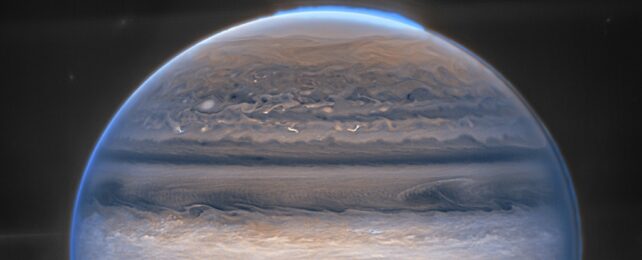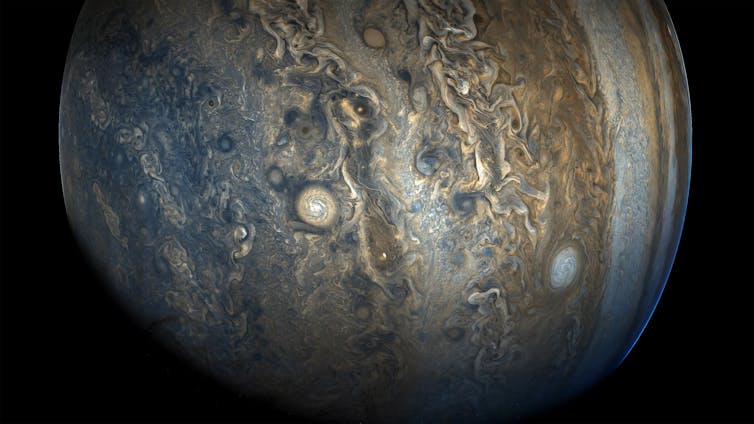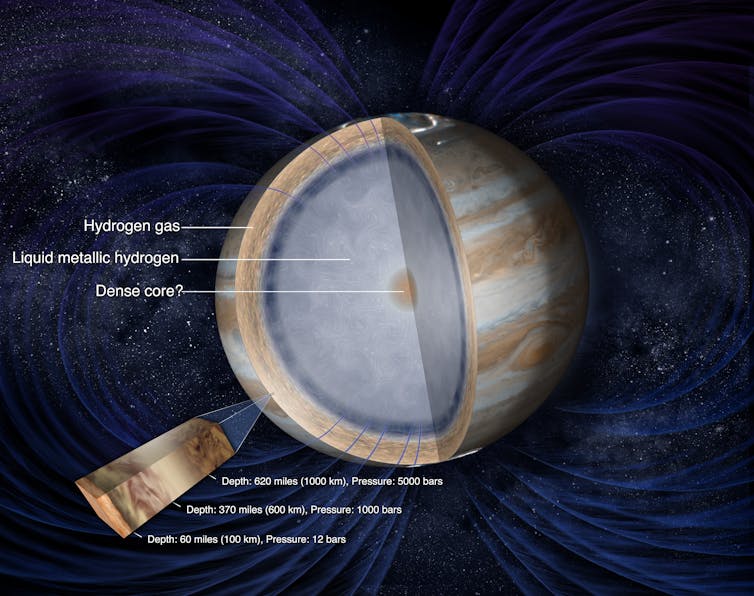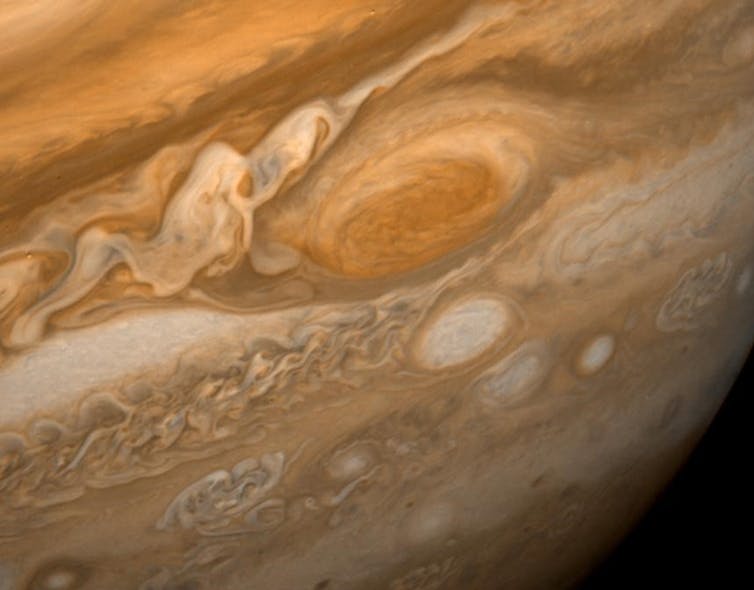
Makes a great narrative but like Earth, we introduce the CORE or DEUS EX MACHINA, whose material content no one has really sampled.
We have introduced the CORE. That surely gives us license to also introduce the EGG SHELL. This immediately eliminates all that matter on the interior of the EGG SHELL because it is a useful barrier. In fact we can project such a shell to even produce a viable surface just where we like it.
We still need an interior Sun to produce an outpouring of matter and radiation. What disappears though is any need for a material impossibilium that we cannot produce in a lab. Or even a neutron stat here.
Again Cloud cosmology supports a special type of interior star that radiates in the ultraviolet and produces .Dark Matter decay products continuously over aeons to produce an outer shell. .
This is an alternate narrative that avoids impossible pressures that cannot exist.
Jupiter Has No Surface. Here's How That's Actually Possible.
Space06 November 2024
ByBenjamin Roulston, The Conversation
The planet Jupiter has no solid ground – no surface, like the grass or dirt you tread here on Earth. There's nothing to walk on, and no place to land a spaceship.
But how can that be? If Jupiter doesn't have a surface, what does it have? How can it hold together?
Even as a professor of physics who studies all kinds of unusual phenomena, I realize the concept of a world without a surface is difficult to fathom. Yet much about Jupiter remains a mystery, even as NASA's robotic probe Juno begins its ninth year orbiting this strange planet.
Jupiter's mass is two-and-a-half times that of all the other planets in the solar system combined.
First, some facts
Jupiter, the fifth planet from the Sun, is between Mars and Saturn. It's the largest planet in the solar system, big enough for more than 1,000 Earths to fit inside, with room to spare.
While the four inner planets of the solar system – Mercury, Venus, Earth and Mars – are all made of solid, rocky material, Jupiter is a gas giant with a composition similar to the Sun; it's a roiling, stormy, wildly turbulent ball of gas. Some places on Jupiter have winds of more than 400 mph (about 640 kilometers per hour), about three times faster than a Category 5 hurricane on Earth.
A photo of the southern hemisphere of Jupiter, taken by NASA's Juno spacecraft in 2017. (NASA/JPL-Caltech/SwRI/MSSS/Gerald Eichstadt/Sean Doran)
Searching for solid ground
Start from the top of Earth's atmosphere, go down about 60 miles (roughly 100 kilometers), and the air pressure continuously increases. Ultimately you hit Earth's surface, either land or water.
Compare that with Jupiter: Start near the top of its mostly hydrogen and helium atmosphere, and like on Earth, the pressure increases the deeper you go. But on Jupiter, the pressure is immense.
As the layers of gas above you push down more and more, it's like being at the bottom of the ocean – but instead of water, you're surrounded by gas. The pressure becomes so intense that the human body would implode; you would be squashed.
Go down 1,000 miles (1,600 kilometers), and the hot, dense gas begins to behave strangely. Eventually, the gas turns into a form of liquid hydrogen, creating what can be thought of as the largest ocean in the solar system, albeit an ocean without water.
Go down another 20,000 miles (about 32,000 kilometers), and the hydrogen becomes more like flowing liquid metal, a material so exotic that only recently, and with great difficulty, have scientists reproduced it in the laboratory. The atoms in this liquid metallic hydrogen are squeezed so tightly that its electrons are free to roam.
Keep in mind that these layer transitions are gradual, not abrupt; the transition from normal hydrogen gas to liquid hydrogen and then to metallic hydrogen happens slowly and smoothly. At no point is there a sharp boundary, solid material or surface.
An illustration of Jupiter's interior layers. One bar is approximately equal to the air pressure at sea level on Earth. (NASA/JPL-Caltech)
Scary to the core
Ultimately, you'd reach the core of Jupiter. This is the central region of Jupiter's interior, and not to be confused with a surface.
Scientists are still debating the exact nature of the core's material. The most favored model: It's not solid, like rock, but more like a hot, dense and possibly metallic mixture of liquid and solid.
The pressure at Jupiter's core is so immense that it would be like 100 million Earth atmospheres pressing down on you – or two Empire State buildings on top of each square inch of your body.
But pressure wouldn't be your only problem. A spacecraft trying to reach Jupiter's core would be melted by the extreme heat – 35,000 degrees Fahrenheit (20,000 degrees Celsius). That's three times hotter than the surface of the Sun.
An image taken of Jupiter by Voyager 1. Note the Great Red Spot, a storm large enough to hold three Earths. (NASA/JPL)
Jupiter helps Earth
Jupiter is a weird and forbidding place. But if Jupiter weren't around, it's possible human beings might not exist.
That's because Jupiter acts as a shield for the inner planets of the solar system, including Earth. With its massive gravitational pull, Jupiter has altered the orbit of asteroids and comets for billions of years.
Without Jupiter's intervention, some of that space debris could have crashed into Earth; if one had been a cataclysmic collision, it could have caused an extinction-level event. Just look at what happened to the dinosaurs.
Maybe Jupiter gave an assist to our existence, but the planet itself is extraordinarily inhospitable to life – at least, life as we know it.
The same is not the case with a Jupiter moon, Europa, perhaps our best chance to find life elsewhere in the solar system.
NASA's Europa Clipper, a robotic probe launching in October 2024, is scheduled to do about 50 fly-bys over that moon to study its enormous underground ocean.
Could something be living in Europa's water? Scientists won't know for a while. Because of Jupiter's distance from Earth, the probe won't arrive until April 2030.

Benjamin Roulston, Assistant Professor of Physics, Clarkson University



No comments:
Post a Comment